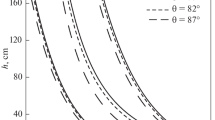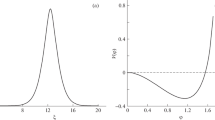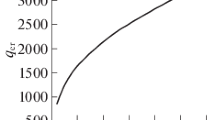Abstract
The possibility is considered of propagation of localized wave structures, such as dust acoustic solitons, in the plasma of the dust-filled Saturn’s magnetosphere, which contains electrons of two sorts (hot and cold) subject to kappa distribution, ions, and charged dust grains. The ranges of possible velocities and amplitudes of the solitons are determined. Soliton solutions for different sizes and concentrations of dust grains in the dust-filled Saturn’s magnetosphere are found.
Similar content being viewed by others
1 INTRODUCTION
It is difficult to imagine a plasma-filled region of the Solar system that would be free of finely dispersed dust grains [1]. Nano- and microsized dust grains are found in interplanetary space, in ionospheric and magnetospheric plasma of the planets of the Solar system, in planetary rings, in the vicinity of space bodies devoid of their own atmosphere, and so on. An important object from the viewpoint of dusty plasma studies is Saturn’s magnetosphere [2, 3]. Its plasma parameters were measured as early as in the 1980s by the Voyager 1 and 2 space missions [4]. Also based on the data collected by the Voyager 1 spacecraft [5], it was shown that waves exist in the magnetospheric plasma of Saturn. Theoretical studies of ion acoustic waves in Saturn’s magnetosphere were carried out in [6]. The dusty plasma in the vicinity of Saturn’s satellite Enceladus was discovered during the Cassini mission [2, 3].
The plasma in Saturn’s magnetosphere has a number of specificities compared with other space systems that are now actively studied (studies of the dusty plasma on Moon and Mars see, e.g., in [7, 8]). For example, measurements of the parameters of electrons in Saturn’s magnetosphere obtained by the Voyager [4, 5] and Cassini [9] missions showed the existence of two types (hot and cold) of electrons. It turned out [9] that the velocities of these electron populations are subject to the so-called kappa distribution with independent low values of κ.
All of this indicates the importance of studying the nonlinear wave structures in the dusty plasma under conditions characteristic of Saturn’s magnetosphere, for which, dust acoustic waves are typical. An important type of nonlinear structures observed in space [10, 11] are solitons. In this work, we consider nonlinear sound structures in the dust-filled Saturn’s magnetosphere characteristic of dusty plasma, namely, dust acoustic solitons [12]. We take into account the two types of electrons (hot and cold) that coexist in Saturn’s magnetosphere and are subject to two different κ distributions. The study is carried out for arbitrary (not small) soliton amplitudes, which appears important for interpreting future space observations.
2 BASIC EQUATIONS
To describe dust acoustic solitons (see, e.g., [13–15]), the following set of equations can be used, which includes the continuity equation, the (Euler) motion equation for the dust grains, and Poisson’s equation for the self-consistent electrostatic potential \(\varphi \) in the dusty plasma of Saturn’s magnetosphere:
where the space variable x corresponds to the propagation direction of the wave perturbation, nd is the concentration of dust grains, \({{v}_{{\text{d}}}}\) is their velocity, md and qd = Zde is the mass and charge of dust grains, \( - e\) is the electron charge, ne,c(h) is the concentration of hot (cold) electrons, and ni is the concentration of ions.
Additionally, it is necessary to take into account the ion and electron distributions that have time to get established over the dust acoustic time scale. It was already noted that, in Saturn’s magnetosphere, the electrons have a κ velocity distribution [16]
where Te,c(h) is the temperature of cold (hot) electrons in energy units, index 0 corresponds to unperturbed states, and κc and κh are the parameters of kappa distributions of the cold and hot electrons, respectively. Note that κc, κh > 3/2.
The ions are subject to Boltzmann’s distribution
where Ti is the ion temperature in energy units.
Taking into account that dust acoustic solitons are relatively slow, and consequently, their characteristic time scale significantly exceeds the characteristic time scale of the change of the charge of dust grains (see, e.g., [17]), the dust grain charges have time to adjust to the plasma parameters and can be determined by the equation
where the macroscopic currents of cold (hot) electrons on the surface of the dust grain are described by the expression [18]
and the microscopic ion current has the form [18]
Here, a is the dust grain size, me(i) is the electron (ion) mass, and Γ(κc(h)) is the gamma function. Note that the values Zd in the soliton obtained from Eq. (4), generally speaking, depend on the electrostatic potential φ. However, according to the conducted calculations that take into account the changes of plasma parameters in the soliton, this dependence is not very strong. For example, even in the maximum of the soliton, where the deviation of its charge from its nonperturbed state is maximum, the charge differs less than 5% from its value at the base of the soliton, including in solitons with a high amplitude (see [17]). This fact allows one to consider the charges of dust grains in the soliton approximately constant, which will be used later.
The nonperturbed concentrations are connected by the quasi-neutrality condition
It is convenient to introduce the total concentration of nonperturbed cold and hot electrons
and the ratio α between the concentrations of hot and cold electrons (\(0 \leqslant \alpha \leqslant 1\)). Then we have
3 SOLITON SOLUTIONS
The system of equations (1)–(7) can be solved by the standard method of Sagdeev potential [19]. To determine the localized wave solution that propagates at some constant velocity M, we can transfer to a new system of coordinates \(\xi = x - Mt\) connected to the wave. In this case, all the parameters of the problem depend only on the new variable \(\xi \). The Sagdeev potential in dimensionless variables \({{e\varphi } \mathord{\left/ {\vphantom {{e\varphi } {{{T}_{{\text{i}}}}}}} \right. \kern-0em} {{{T}_{{\text{i}}}}}} \to \varphi \), \({M \mathord{\left/ {\vphantom {M {{{C}_{{{\text{Sd}}}}}}}} \right. \kern-0em} {{{C}_{{{\text{Sd}}}}}}} \to M\), \({\xi \mathord{\left/ {\vphantom {\xi {{{\lambda }_{{{\text{Di}}}}}}}} \right. \kern-0em} {{{\lambda }_{{{\text{Di}}}}}}} \to \xi \), where \({{C}_{{{\text{Sd}}}}} = \sqrt {{{{{T}_{{\text{i}}}}} \mathord{\left/ {\vphantom {{{{T}_{{\text{i}}}}} {{{m}_{{\text{d}}}}}}} \right. \kern-0em} {{{m}_{{\text{d}}}}}}} \) and \({{\lambda }_{{{\text{Di}}}}} = \sqrt {{{{{T}_{{\text{i}}}}} \mathord{\left/ {\vphantom {{{{T}_{{\text{i}}}}} {4\pi {{n}_{{{\text{i0}}}}}{{e}^{2}}}}} \right. \kern-0em} {4\pi {{n}_{{{\text{i0}}}}}{{e}^{2}}}}} \) has the form
where \(d = {{{{n}_{{{\text{d}}0}}}} \mathord{\left/ {\vphantom {{{{n}_{{{\text{d}}0}}}} {{{n}_{{{\text{i0}}}}}}}} \right. \kern-0em} {{{n}_{{{\text{i0}}}}}}}\), \({{\tau }_{{\text{c}}}} = {{{{T}_{{{\text{ec}}}}}} \mathord{\left/ {\vphantom {{{{T}_{{{\text{ec}}}}}} {{{T}_{{\text{i}}}}}}} \right. \kern-0em} {{{T}_{{\text{i}}}}}}\), \({{\tau }_{{\text{h}}}} = {{{{T}_{{{\text{eh}}}}}} \mathord{\left/ {\vphantom {{{{T}_{{{\text{eh}}}}}} {{{T}_{{\text{i}}}}}}} \right. \kern-0em} {{{T}_{{\text{i}}}}}}\).
The soliton solution is found from the relation
where φξ is the first derivative of function φ with respect to ξ.
The scope (\({{M}_{{\min }}} < M < {{M}_{{\max }}}\)) of localized wave solutions is determined by the conditions of their existence and has the form
Below, results are given for calculations that were carried out for the following parameters of Saturn’s magnetosphere (see [4, 6, 9]): ni0 = 10 cm–3, Ti = 100 K, Tec = 10 eV, Teh = 700 eV, \(\alpha = 0.5\), and κc = κh = 2.
Figure 1 shows the dependences of charge numbers Zd of the dust grains and total electron concentra-tions ne0 on dust grain size for different concentrations of dust grains. The values Zd and ne0 were obtained at the given value of ni0 based on the self-consistent solution of Eqs. (4)–(7).
Figure 2 shows the amplitudes of dust acoustic solitons depending on dust grain size in the entire possible range of dimensionless velocities M at different dust grain concentrations. Figures 3–5 show the characteristic types of solitons (panels a) and the corresponding Sagdeev potentials (panels b and c) for the cases with different concentrations and sizes of dust grains and different values of the dimensionless velocity M. It is seen that, in the entire scope of amplitude of the dust acoustic solitons, φ0 is negative and their amplitudes can be relatively high (of the order of Ti /e).
The same as in Fig. 3 for nd0 = 10–3 cm–3, M = 100.
The same as in Fig. 3 for nd0 = 10–4 cm–3, M = 300 for soliton 1 and M = 60 for soliton 2.
4 CONCLUSIONS
In this work, the possibility was shown of the propagation of localized wave structures, such as dust acoustic solitons, in the dust-filled Saturn’s magnetosphere, which includes electrons of two types (hot and cold), ions, and charged dust grains. The regions of possible velocities and amplitudes of the solitons were determined. Soliton solutions were found for different sizes and concentrations of dust grains in the dust-filled plasma of Saturn’s magnetosphere. It turns out that in their entire scope, the amplitudes of electrostatic potential of dust acoustic solitons are negative. At the same time, their absolute values can be relatively high (of the order of Ti /e), which indicates that dust acoustic solitons can be observed in Saturn’s magnetosphere by future space missions.
REFERENCES
S. I. Popel, Priroda, No. 9, 48 (2015).
J.-E. Wahlund, M. André, A. I. E. Eriksson, M. Lundberg, M. W. Morooka, M. Shafiq, T. F. Averkamp, D. A. Gurnett, G. B. Hospodarsky, W. S. Kurth, K. S. Jacobsen, A. Pedersen, W. Farrell, S. Ratynskaia, and N. Piskunov, Planet. Space Sci. 57, 1795 (2009).
V. V. Yaroshenko, S. Ratynskaia, J. Olson, N. Brenning, J.-E. Wahlund, M. Morooka, W. S. Kurth, D. A. Gurnett, and G. E. Morfill, Planet. Space Sci. 57, 1807 (2009).
E. C. Sittler, Jr., K. W. Ogilvie, and J. D. Scudde, J. Geophys. Res.: Space Phys. 88, 8847 (1983).
D. D. Barbosa and W. S. Kurth, J. Geophys. Res.: Space Phys. 98, 9351 (1993).
E. J. Koen, A. B. Collier, S. K. Maharaj, and M. A. Hellberg, Phys. Plasmas 21, 072122 (2014).
S. I. Popel, L. M. Zelenyi, A. P. Golub’, and A. Yu. Dubinskii, Planet. Space Sci. 156, 71 (2018).
A. P. Golub’ and S. I. Popel, JETP Lett. 113, 428 (2021).
P. Schippers, M. Blanc, N. André, I. Dandouras, G. R. Lewis, L. K. Gilbert, A. M. Persoon, N. Krupp, D. A. Gurnett, A. J. Coates, S. M. Krimigis, D. T. Young, and M. K. Dougherty, J. Geophys. Res.: Space Phys. 113, A07208 (2008).
H. L. Pécseli, B. Lybekk, J. Trulsen, and A. Eriksson, Plasma Phys. Control. Fusion 39, A227 (1997).
S. I. Popel, Plasma Phys. Rep. 27, 448 (2001).
S. I. Kopnin, I. N. Kosarev, S. I. Popel, and M. Yu, Plasma Phys. Rep. 31, 198 (2005).
S. I. Kopnin and S. I. Popel, Tech. Phys. Lett. 45, 1035 (2019).
S. I. Kopnin, T. I. Morozova, and S. I. Popel, Plasma Phys. Rep. 45, 855 (2019).
S. I. Kopnin and S. I. Popel, Tech. Phys. Lett. (2021). https://doi.org/10.1134/S1063785021050102
G. Banerjee and S. Maitra, Phys. Plasmas 22, 043708 (2015).
S. I. Popel, S. I. Kopnin, I. N. Kosarev, and M. Y. Yu, Adv. Space Res. 37, 414 (2006).
N. Rubab and G. Murtaza, Phys. Scr. 73, 178 (2006). https://doi.org/10.1088/0031-8949/73/2/009
R. Z. Sagdeev, in Reviews of Plasma Physics, Ed. by M. A. Leontovich (Consultants Bureau, New York, 1968), Vol. 4, p. 23.
Funding
This work was supported by the BASIS Foundation for the Development of Theoretical Physics and Mathematics.
Author information
Authors and Affiliations
Corresponding author
Ethics declarations
The authors declare no conflict of interest.
Additional information
Translated by E. Voronova
Rights and permissions
Open Access. This article is licensed under a Creative Commons Attribution 4.0 International License, which permits use, sharing, adaptation, distribution and reproduction in any medium or format, as long as you give appropriate credit to the original author(s) and the source, provide a link to the Creative Commons license, and indicate if changes were made. The images or other third party material in this article are included in the article’s Creative Commons license, unless indicated otherwise in a credit line to the material. If material is not included in the article’s Creative Commons license and your intended use is not permitted by s-tatutory regulation or exceeds the permitted use, you will need to obtain permission directly from the copyright holder. To view a copy of this license, visit http://creativecommons.org/licenses/by/4.0/.
About this article
Cite this article
Kopnin, S.I., Shokhrin, D.V. & Popel, S.I. Dust Acoustic Solitons in Saturn’s Dust-Filled Magnetosphere. Plasma Phys. Rep. 48, 141–146 (2022). https://doi.org/10.1134/S1063780X2201007X
Received:
Revised:
Accepted:
Published:
Issue Date:
DOI: https://doi.org/10.1134/S1063780X2201007X









